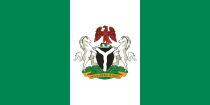
Back Vlag van Nigerië Afrikaans የናይጀሪያ ሰንደቅ ዓላማ Amharic Egop Ido Naijiria ANN علم نيجيريا Arabic Bandera de Nixeria AST Nigeriya bayrağı Azerbaijani Сцяг Нігерыі Byelorussian Сьцяг Нігерыі BE-X-OLD Национално знаме на Нигерия Bulgarian নাইজেরিয়ার ফিরালহান BPY
 | |
| Use | National flag |
|---|---|
| Proportion | 1:2 |
| Adopted | 1 October 1960 |
| Design | A vertical bicolour triband of green, white and green. |
| Designed by | Michael Taiwo Akinkunmi |
 | |
| Use | State flag |
| Proportion | 1:2 |
| Design | A vertical bicolour triband of a green, white and green; charged with the coat of arms in the centre. |
 | |
| Use | Civil ensign |
| Proportion | 1:2 |
| Design | A red field with the national flag, in the canton |
 | |
| Use | State ensign |
| Proportion | 1:2 |
| Design | A blue field with the national flag, in the canton |
 | |
| Use | Naval ensign |
| Proportion | 1:2 |
| Design | A white field with the national flag in the canton, with the Naval seal in the fly. |
 | |
| Use | Air force ensign |
| Proportion | 1:2 |
| Design | A sky-blue field with the national flag in the canton, with the air force roundel in the fly. |

The flag of Nigeria was designed by Michael Taiwo Akinkunmi and was officially adopted to represent Nigeria at midnight on 1 October 1960, the day the country gained independence. The flag was chosen as part of a nationwide open contest held by the government, with Akinkunmi's design being selected as the winner of a field of over three thousand entries. The flag is a vertical bicolour green-white-green design, with the green to represent agriculture and white to represent peace and unity.
The flag was raised for the first time in a ceremony by Lieutenant David Ejoor of the Army Guard.